April 30, 2010
Air Date: April 30, 2010
FULL SHOW
SEGMENTS
Oil Spill Clouds Support for Offshore Drilling
View the page for this story
Tons of crude spewing from an oil rig in the Gulf of Mexico has given some reason to reconsider President Obama's recent decision to expand oil and gas exploration off the nation's Atlantic and Gulf coasts. Host Jeff Young talks with St. Petersburg Times reporter Craig Pittman about the growing opposition to offshore oil drilling. (05:30)
A Win for Wind Power
View the page for this story
After a decade-long battle, the Cape Wind offshore wind farm has been approved by the federal government. Host Jeff Young talks with Denise Bode of the American Wind Energy Association about what the federal green light will mean for the future of wind power in the United States. (06:30)
The Spores of Sickness
View the page for this story
Valley Fever is a fungus that makes its way from dry dirt into the respiratory system and it’s rapidly spreading the central California and parts of the Southwest. As Living on Earth and Planet Harmony’s Mwende Hahsey (Hay-see) reports, experts say the fungus is especially harmful to African Americans and Hispanics. (05:40)
Judging Biotech Seeds
/ Jessica Ilyse KurnView the page for this story
The first case involving genetically engineered crops is being argued in the U.S. Supreme Court. Monsanto is challenging a lower court’s decision to halt the sale of the agri-giant’s genetically engineered alfalfa seed without adequate environmental review. As Jessica Ilyse Smith reports, this precedent-setting case may determine how biotech crops are regulated in the future. (06:00)
Agriculture in Rhythm
View the page for this story
You can't take the culture out of agriculture. That's the view of Cuban musician and scientist Humberto Rios. He's won this year's Goldman Prize for his contribution to sustainable farming on the island and he speaks with host Jeff Young. (06:30)
Earth Poetry
View the page for this story
Poet Janice Harrington writes of time, nature, and memory in her poem Shaking the Grass. (03:00)
Documerica
View the page for this story
Forty years ago, the newly-formed EPA sent photographers all over the country to document America’s environmental problems and its natural beauty. What they came back with is a remarkable picture of America in the early 1970s. Host Jeff Young talks with National Archives curator Bruce Bustard and joins photographer Michael Manhein as he returns to the site he photographed decades ago for the project. (11:15)
Bird Wonder
View the page for this story
At this time of year, many migratory birds have been returning to their North American homes. But with insects and seed not yet plentiful, the birds have been flocking to backyard birdfeeders. Commentator Tom Montgomery-Fate has been watching these recent arrivals with his young son. (02:40)
Show Credits and Funders
Show Transcript
HOST: Jeff Young
REPORTERS: Mwende Hahesy, Jessica Ilyse Smith
GUESTS: Craig Pittman, Denise Bode, Humberto Rios, Tom Montgomery-Fate, Michael Manheim
POET: Janice Harrington
YOUNG: From Public Radio International, this is Living on Earth. The spill and the drill the political fallout of the Gulf of Mexico’s oilrig disaster.
PITTMAN: We did a search through the transcripts of all the people who had been saying “drill, baby, drill” for the past two years, we can’t find that any of them have commented on the spill yet. There’s been a roaring silence.
YOUNG: The massive oil spill sours the taste for light, sweet crude, and could shift the debate on offshore drilling. Meanwhile, another coast welcomes the country’s first offshore wind farm.
AIKENS: This is about jobs; this is real jobs, clean energy for America. There’s tin knockers, there’s iron workers, there’s carpenters, there’s pile drivers, I mean—we’re all in this.
YOUNG: A tale of two coastlines and the choices for off shore energy. Those stories and poetry inspired by nature this week on Living on Earth. Stick around.
[THEME]
Oil Spill Clouds Support for Offshore Drilling
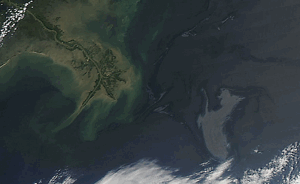
The oil slick appears as a dull gray south of the Mississippi delta.
YOUNG: From the Jennifer and Ted Stanley Studios in Somerville, Massachusetts—this is Living on Earth. I’m Jeff Young. Offshore energy splashed into the headlines this past week with a wind power announcement for Nantucket Sound and a disastrous oil spill in the Gulf of Mexico.
NAPOLITANO: We’ll be taking a very close look at efforts underway, particularly to minimize the environmental risks in the area affected by the leaking oil.
SALAZAR: Cape wind will be the United States’ first offshore wind farm. Supplying clean power to homes and businesses in Massachusetts while creating good jobs here in America.
YOUNG: That’s Interior Secretary Ken Salazar approving the Cape Wind Project after nine years of controversy. We’ll have analysis of what that might mean for the country’s nascent offshore wind industry.
But first, more on the spill in the Gulf and the fallout for offshore drilling. Just weeks ago, President Obama announced his plan to open more of the country’s coasts to drilling. Here’s how the president explained that decision in early April.
OBAMA: It turns out by the way that oilrigs today generally don't cause spills, they are technologically very advanced.
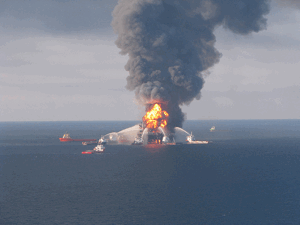
The Deepwater Horizon Platform fire April 20th (Courtesy of the U.S. Coast Guard)
YOUNG: Now, with eleven workers dead and a desperate scramble to prevent an ecological catastrophe, many politicians are rethinking their position. Florida’s Gulf Coast is the frontline in this debate. If drilling expands it would likely happen first in the Eastern Gulf. That’s where Craig Pittman covers the environment for the St. Petersburg Times. Pittman says public opinion in Florida is, like the spill, a fluid situation.
PITTMAN: There has definitely been an evolution in the public attitude. In the late ‘80s, early ‘90s, I covered public hearings on offshore drilling where it would draw hundreds of people from all walks of life. You’d see skate punks with Mohawks standing next to button-down guys from the chamber of commerce, republicans and democrats joining forces, everybody saying we don’t want drilling off our shores here in Florida—that was the third rail of Florida politics.
But then came the summer of four-dollar gasoline and people started reconsidering that position, and saying well, gee if the tourists can’t afford to drive down here in the first place, what’s the point of having these clean beaches? You know, maybe it’s worth the risk.
YOUNG: So how do you think this is going to affect public opinion in Florida?
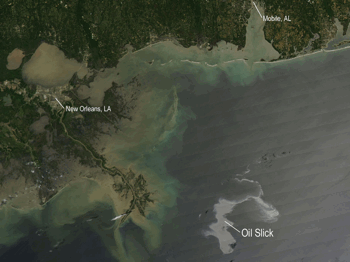
The oil slick emerging from the accident in the Gulf of Mexico days after the accident. (Courtesy of NASA)
PITTMAN: It’s as if the third rail of Florida politics has suddenly become a live wire again. It seems to have push a lot of people who were saying I’m open to the idea of drilling to say ok, now we’ve seen what it looks like, maybe it’s not such a good idea. The most immediate effect was that governor Charlie Crist who is running for the U.S. Senate announced that he is rethinking his support for offshore drilling.
CRIST: Well, if this doesn’t give somebody pause there’s something wrong I think. This is as I understand it a pretty new rig, and as I’ve always said it would need to be far enough, clean enough, and safe enough. I’m not sure that this was far enough, I’m pretty sure it wasn’t clean enough, and it doesn’t sound like it was safe enough.
PITTMAN: He had said during the 2008 presidential race when he was being considered for vice president by John McCain that he was open to the idea of offshore drilling. That was his mantra, he said, I’ll support it if it’s clean enough, safe enough, and far enough away to protect the beaches.
Obviously now we have a spill very far away from Florida that is drifting closer and closer to our shores and he’s saying maybe there’s not a place that’s far enough away. So he seems to be staking out his own course in order to separate himself from some of the more conservative elements of the Republican Party.
YOUNG: So you’re current senators, senators LeMieux and Nelson—where do they stand on this, and where’s the rest of the congressional delegation you think?
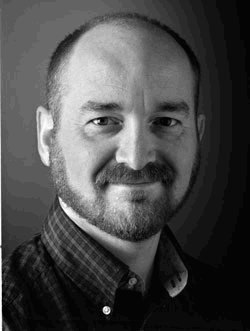
St Petersburg Times Reporter Craig Pittman.
PITTMAN: Senator LeMieux said that he would like to find out what sort of safety requirements should be changed in order to make sure this doesn’t happen again. Senator Nelson who is a long-time opponent of offshore drilling in the eastern Gulf of Mexico has seized on this issue as you might expect he would and said we need a full investigation, we think the oil companies have not been telling the truth about their safety record, and we think this is a further reason for trying to persuade president Obama to back off his plan to open up more of the eastern Gulf to drilling.
In fact, two of our congressmen joined forces—republican and democrat—to send the president a letter saying back of your plan, we don’t want it close to Florida, we don’t like what we’re seeing out there.
YOUNG: So, if part of the deal for trying to get a comprehensive energy and climate bill through Congress is to include offshore drilling, is that now vulnerable you think because it sounds to me like senator Nelson of Florida has a little more ammo to push back against.
PITTMAN: Absolutely. And he’s not alone—two senators from New Jersey have also weighed in and said look what happened, this is terrible, and we don’t want it off our shore, and they are joining senator Nelson in calling for congressional hearings and investigation.
YOUNG: So where do you see this heading? Is this yet another temporary turn in public opinion for Florida and for the nation? Or do you think this might have a more lasting impact, this accident we were watching unfolding in the Gulf?
PITTMAN: I think it depends on how big it gets and how bad it gets. I mean people still talk about the Santa Barbara spill from California, people in the Gulf still talk about the big Ixtoc spill off of Mexico that went on for two months and coated the beaches of Texas with tar balls for years afterwards. The big ones people remember and it affects political patterns for a long time to come. If on the other hand it winds up being easy to clean up, well, then it’ll be forgotten by the next election cycle, probably.
YOUNG: Do you think this spill in the Gulf is going to be the—is this the end of “drill, baby, drill” or is it just now going to ring to people’s ears as “spill, baby, spill”?
PITTMAN: That’s a really good question. Let me answer it by saying this: we did a search through the transcripts of all the people who had been saying “drill, baby, drill” for the past two years: Newt Gingrich, Shawn Hannity, Rush Limbaugh, Glenn Beck—all those folks—Sarah Palin; we can’t find that any of them have commented on the spill yet. There’s been a roaring silence.
YOUNG: Craig Pittman is a staff writer for the St. Petersburg Times. Thanks very much!
PITTMAN: You’re welcome.
Related links:
- For more on Craig Pittman and his work click here.
- Click here to hear a webextra on how wildlife will be affected by the Gulf oil spill
- Click here for Carl Safina on Blue Fin Tuna and the Oil Spill
A Win for Wind Power
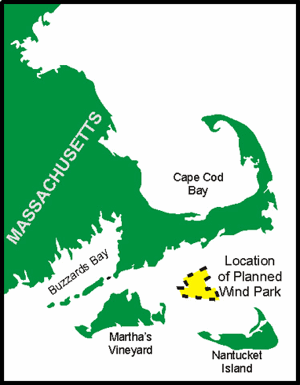
The proposed site for the Cape Wind project in Nantucket Sound, Massachusetts.
YOUNG: While the Gulf is dealing with oil, the New England Coast is banking on the wind. Despite some strong objections, Interior Secretary Ken Salazar approved the permit for the offshore facility called Cape Wind.
SALAZAR: I am approving the Cape Wind project with modifications that will help protect the historic cultural and environmental resources of Nantucket sound. This will be the first of many projects up and down the Atlantic coast as we build a new energy future for our country.
YOUNG: Salazar says Cape Wind’s 130 turbines could generate 468 megawatts of carbon-free power, about as much as an average coal fired power plant. It could also generate a thousand jobs, something that excites Marty Aikens of the local electric workers union.
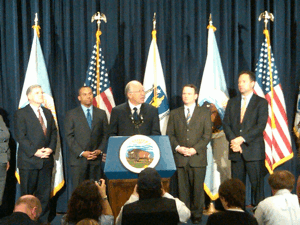
Ken Salazar (center) announces federal approval for the Cape Wind project. (Photo: Jeff Young)
AIKENS: This is about jobs; this is real jobs, clean energy for America. There’s tin knockers, there’s iron workers, there’s carpenters, there’s pile drivers, I mean—we’re all in this.
YOUNG: We asked Denise Bode, CEO of the American Wind Energy Association, to find out what the Cape Wind decision means.
BODE: It is a first major step forward to really creating a brand new source of electric generation that is even very high capacity generation because offshore wind is very reliable and if we get policies in place, the long-term commitment of a renewable electric standard and comprehensive energy policy and climate policy in place in the U.S. that will send the signal that that industry is ready to be built out here in the United States.
YOUNG: Give us a status report on the various offshore proposals. I hear a lot from different states—Delaware, New Jersey, Rhode Island—how many projects are in the works, and how close are they to getting in the water?
BODE: There’s a project in Delaware and three projects in New Jersey, two projects in Rhode Island and one in Texas, one in North Carolina, and then one in the Great Lakes from Ohio. So there are all up and down the coast in the Gulf and in the Great Lakes.
They’re taking a look at doing at, and in addition, there are others in the development pipeline, including projects off the Virginia coast, and near New York in Lake Erie, as well. Many of them actually already have signed, purchased power agreements with utilities and are being actively encouraged by the governor and the economic development in their home states.
YOUNG: So clearly there’s a lot of excitement about the potential here, but Cape Wind is not a done deal yet as the opponents are quick to point out. Here’s Audra Parker, she’s president of the Alliance to Protect Nantucket Sound:
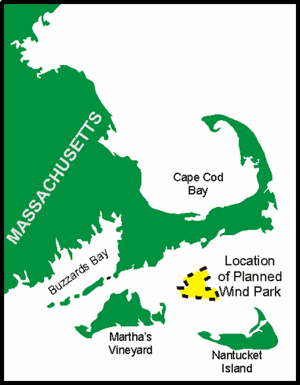
The proposed site for the Cape Wind project in Nantucket Sound, Massachusetts.
PARKER: I think this is so far from over. State and local permits are being challenged in the state court. There is no sort of power contract for Cape Wind and we have an extremely strong legal case in the federal court, so I believe we will win.
YOUNG: So, what happens, Denise Bode, if Cape Wind ends up mired in court battles, what kind of signal does that send to these other offshore wind projects?
BODE: I think the main signal that we have is secretary Salazar declaring that he thinks this offshore wind project should go forward. So if not this project, clearly the next one that’s in the pipeline will know that they will receive long-term commitment from at least this administration to move forward on those.
YOUNG: Another thing the opponents of Cape Wind point out, and I think this also applies to the other projects potentially, and that is there’s no contract yet to sell the electricity produced into the grid. How big an obstacle is that? Can offshore wind be cost-competitive?
BODE: When you consider over time having higher capacity electric generation coming from these offshore projects, I mean, the end product is going to be very affordable over a 20- or 30-year period. So your upfront cost is going to be a little more expensive, but once you get the industry billed out, it’s going to be one that’s going to be very, very cost-competitive.
YOUNG: But we’re in such tangle in Congress trying to get a climate bill passed.
BODE: Right.
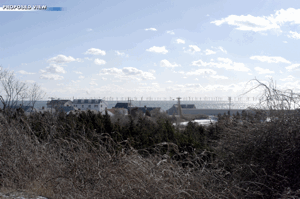
A simulation prepared by Cape Wind shows the view from Craigville, 6.5 miles from the windmills. (Courtesy of Cape Wind)
YOUNG: If that is, pardon the pun, but up in the air, isn’t offshore wind power up in the air, too?
BODE: The real ability to move on the ball forward on all these installations and manufacturing starts really is the renewable electric standard. But having that as part of a broader package that puts a price on carbon really cinches the deal.
YOUNG: The timing of these two events—the Cape Wind decision coming just as we’re watching this oil spill unfold in the Gulf—what does this tell us about where were headed with energy from our shores and the choices we have along our coasts?
BODE: Well, I bet those folks in Louisiana wish they had a wind farm down there as opposed to having those oil rigs. I mean the thing to take from this is that you have to make choices when you look at what your source of energy is going to be.
And we think we offer absolutely the best, most sustainable, supportable source of electricity out there. I think the turbines are magnificent, they’re a symbol of our dedication and our commitment to our kids’ future, and to having clean air, and having a clean environment, and to having jobs for them.
YOUNG: Denise Bode, CEO of the American Wind Energy Association. Thank you very much.
BODE: Wonderful to be with you.
Related links:
- Secretary Salazar’s response to the ACHP comments.
- Cape Wind
- Living On Earth Story: The Battle for Cape Wind
- American Wind Energy Association
- Alliance to Protect Nantucket Sound
[Chuck Brown “ Game Seven” from Bustin Loose (Source Records 1978)]
YOUNG: There’s much more about Cape Wind on our website, and updates about the oil spill. Check out l-o-e dot org.
[MUSIC]
YOUNG: Coming up—seeds as a cause for celebration and litigation—keep listening to Living on Earth!
The Spores of Sickness
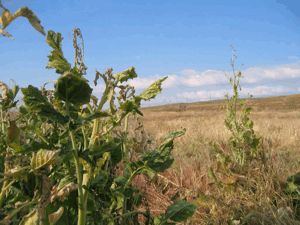
Valley Fever spores thrive in the dry, alkaline soil, found in the southwest USA. (Photo: Mwende Hahesy)
YOUNG: It’s Living on Earth, I’m Jeff Young. It’s called Coccidioidomycosis. Or to the layman, Valley Fever. It’s caused by an airborne fungus in some dry parts of the American west. Most often Valley Fever causes flu-like symptoms but for some it wreaks havoc throughout the body. It hits hardest among African- and Hispanic-Americans. Doctors think the reasons are both genetic and socioeconomic. Mwende Hahesy has the story.
HAHESY: Valley Fever isn't well known. Even within California and Arizona where it's found. Yet it's the most common and fastest growing infectious disease in Central California. And Valley Fever has made thousands of people really sick. People like Jonita Hodge. Back in 2006 her doctor told her:
HODGE: Doctor Amin Navinchandara says, there’s no medical reason you’re here. You better go to your prayer closet and thank someone!
[HODGE AND HAHESY LAUGH]
HAHESY: We met in northeast Bakersfield where she lives. It’s your typical California suburban neighborhood with wide streets and identical homes. Nearby construction churns up the dirt and with dirt cocci spores.
Jonita is a lifelong athlete. She’s coached basketball and volleyball for nearly 23 years, but her former six-foot self shrank when she lost an entire vertebra to the fungus. Her hair’s become so brittle it just breaks off. Now she wears a wig. The infection left her with scalely skin and painful bumps and scars all over her legs.
HODGE: Pain was—I had two kids complete natural birth and I’ll tell you it was worse.
HAHESY: Jonita’s doctor, Amin Navinchandara is an infectious disease specialist in Bakersfield, California. He says even though black and brown people make up 40 percent of Bakersfield’s population they account for 80 percent of serious Valley Fever cases that he sees. Only recently have researchers suggested that there may be a genetic reason why people of color suffer more from Valley Fever.
AMIN: It is usually biological because we think that this group of people probably have a gene in them, which doesn’t allow them to fight the fungus.
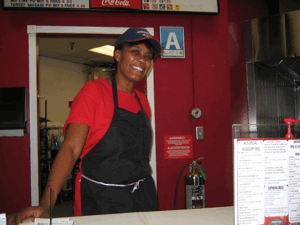
Johnita Hodge takes antibiotics every day to keep her Valley Fever subdued. (Photo: Mwende Hahesy)
HAHESY: Scientists haven’t pinpointed the biological reason minority populations get it worse…
AMIN: But, it can be environmental, as well.
HAHESY: The environmental and social factors are more obvious once you understand how people usually catch Valley Fever.
AMIN: When the soil is being disturbed, this particular fungus turns into a spore or a bubble.
HAHESY: These spore packs dislodge when people dig into the dirt.
[SOUND OF SHOVEL DIGGING]
AMIN: And this bubble comes into the air…
HAHESY: And with a puff of air…
[SOUNDS OF WIND]
HAHESY: The bubble pops open…
[POP!]
HAHESY: Releasing the cocci spores.
[SPRAYING SOUNDS]
AMIN: And all an individual need to do is inhale about ten to 15 spores.
HAHESY: A dozen spores can make you sick. Factor in a scary dust storm and we’re talking ten times the load needed.
[MULTIPLE POPS]

Valley Fever is a fast growing disease from the South West to Central California. (Photo: Mwende Hahesy)
HAHESY: Many brown-skinned people work in construction and agriculture. They’re the ones more likely to be around freshly stirred up spores. The infection starts off small, with a cough. Then gets worse the longer Valley Fever goes untreated, or as with Jonita, the longer it goes misdiagnosed.
HODGE: From 2003 to 2006 there was not one signal Valley Fever test. I had been tested for AIDS three times, I had been tested for every disease you can think of including sickle cell a couple of times, but full blood work does not include Valley Fever.
HAHESY: It took a friend’s vision to push Jonita to ask for a Valley Fever test.
HODGE: A friend of mine actually called me. She says, how you been feeling? Have you been sick? I say, as a matter of fact, I have been. And she said, I don’t want to scare you or anything, but the lord told me you have Valley Fever.
HAHESY: Valley Fever is easily treatable, especially if the infection hasn’t spread past the lungs. Amphotericin is one of the go-to antibiotics used to treat the infection.
HODGE: When you get a weed in your yard, if you get a little piece of it, if you don’t kill it right away, it will just take over your entire yard, and then you’ve got to come with Roundup and that’s what the amphotericin is basically Roundup. And what happens when you have a weed and it grows back? It comes back stronger.
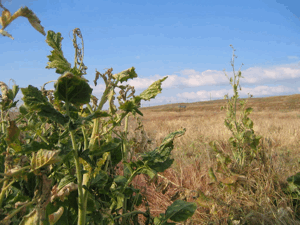
Valley Fever spores thrive in the dry, alkaline soil, found in the southwest USA. (Photo: Mwende Hahesy)
HAHESY: Jonita has to take antibiotics for the rest of her life. Her body was so ravaged by the Valley Fever that it will return if she doesn’t. This scenario is playing out more and more often. Again, here’s doctor Amin.
AMIN: I came here in 1979; at that time we were seeing on an average about 200 cases a year. And now it has virtually run to 2,000 cases a year.
HAHESY: The effects of climate change may make the valley and the southwestern soil drier and more hospitable to the fungus. To those in the area doctor Amin has this advice:
AMEEN: When we ever have a dust storm, stay out of the wind. Don’t go out, particularly people who are in the high-risk group.
HAHESY: Currently, there is little funding for a vaccine. And not that many people are talking about prevention and treatment of Valley Fever. But doctors say without addressing these issues there will only be more cases like Jonita’s. For Planet Harmony and Living on Earth in Bakersfield, California. This is Mwende Hahesy.
[The Headhunters “Ms Yum Yum” from Straight From The Gate (Arista Records 1977)]
YOUNG: Mwende is a reporter from our brand new online offering, Planet Harmony, which welcomes all and is designed to have special appeal for young African-Americans. Check it out and join the discussion at My Planet Harmony dot com. That’s myplanetharmony dot com.
[The Headhunters “Ms Yum Yum” from Straight From The Gate (Arista Records 1977)]
Judging Biotech Seeds

Alfalfa forage is used as feed for dairy cows and cattle. (Courtesy of Monsanto)
YOUNG: The U.S. Supreme Court has just heard its first case involving genetically engineered crops. The Monsanto Corporation is appealing a lower court decision that halts sales of genetically engineered alfalfa seed. So-called “Roundup Ready” alfalfa is engineered to survive when the herbicide Roundup is applied to the fields. Living on Earth’s Jessica Ilyse Smith reports that this case could set a precedent for the future of biotech agriculture.
SMITH: Four years ago The Center for Food Safety sued the U.S. Department of Agriculture claiming that Roundup Ready alfalfa was approved without adequate environmental review. The Center represents a coalition of seed farms, non-profits, and environmental groups that contend the use of genetically engineered alfalfa poses ecological harm.
Law professor Susan Schneider says the coalition wants the government to apply the National Environmental Policy Act, known as NEPA, before approving Roundup Ready alfalfa for use.
SCHNEIDER: NEPA requires that whenever a federal agency undertakes a federal action that can significantly affect the quality of the environment, the agency is supposed to consider and document potential environmental effects of their actions.
SMITH: Schneider is the director of the Agriculture and Food Law program at the University of Arkansas School of Law. She’s watching this case closely.
SCHNEIDER: I think that the notion that an environmental impact statement should be prepared prior to deregulating a genetically engineered crop is something that I think is coming of its own now.
SMITH: The lower court agreed with the Center that an Environmental Impact Statement was warranted—a first for a genetically engineered crop. The court ordered an injunction to restrict sales of Roundup Ready alfalfa until an environmental review was complete. Monsanto appealed. And the case has climbed the legal ladder to the U.S. Supreme Court. Garrett Kasper of Monsanto says the case is about more than just alfalfa.
KASPER: It boils down to three things: farmers, fairness and freedom to choose.
SMITH: Kasper says Monsanto wants farmers to have the autonomy to plant GE Alfalfa along with the pesticide Roundup so they can grow the crop weed-free.
KASPER: Our hope is that farmers will be able to count on the USDA’s approval of biotech crops and they’ll also be able to know that challenges to biotech is based on scientific evidence and, then, at the end of the day have the choice to use these products.
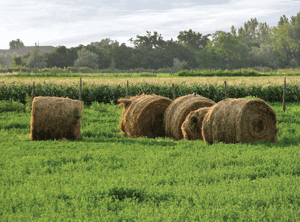
Alfalfa forage is used as feed for dairy cows and cattle. (Courtesy of Monsanto)
SMITH: Choice is the key word here. While Monsanto says farmers should have the choice to use genetically engineered alfalfa, The Center for Food Safety’s staff attorney George Kimbrell sees it another way. Kimbrell says the threat of spreading GE alfalfa demonstrates a loss of choice.
KIMBRELL: If you’re a farmer and you want to grow an organic alfalfa crop or a conventional alfalfa crop and you can’t because of contamination or the threat of contamination, there is no amount of money that will remedy that harm.
And to the extent that you are a consumer and you want to have the choice to buy non-genetically engineered food that is also an irreparable harm. That is, there is no amount of money that can give you back your choice.
SMITH: Alfalfa is used as a feed for cattle and dairy cows. Organic dairy farmers rely on their feed to be GE-free so they worry Roundup Ready alfalfa will threaten their ability to produce an organic product. To address this issue the USDA has set rules for how far apart farmers can plant GE seeds from other farms. Monsanto says these buffer zones are in their contracts, which farmers sign when they buy seeds.
But, some environmental groups point out that since alfalfa is a perennial crop it will stick around for many consecutive years. And alfalfa is openly pollinated by bees. Kimbrell from the Center for Food Safety says nature can’t always be regulated.
KIMBRELL: Bees are wild they don’t read signs. So even if you have an isolation distance of say 900 feet or 1400 feet, which is some of the ones they propose for example. If you have a wild honeybee that can fly five miles, that’s not going to do you much good.
SMITH: The Supreme Court will decide if there is enough harm to continue to halt the sales of Roundup Ready Alfalfa. In past cases it all came down to definitions: possibility of harm versus likely harm. Law professor Susan Schneider says in Monsanto’s case these definitions are also under scrutiny.
SCHNEIDER: Is it based simply on a percentage of how likely the harm is gonna be? Or in fact should we be looking at the specific harm that’s involved and how serious a danger that presents. And that’s where you get into some of the really technical legal issues that are before the court.
SMITH: To Garrett Kasper of Monsanto, the approval of Roundup Ready alfalfa does not present permanent harm.
KASPER: To call it irreparable harm is certainly a stretch. If anything it might be financial, which is reparable through other means.
SMITH: The Center for Food Safety’s George Kimbrell disagrees. He says there are environmental impacts linked to growing GE alfalfa—like contaminating wild alfalfa plants or damaging the organic market.
KIMBRELL: In the legal sense economic injury is not by itself irreparable but here when it’s intertwined with a permanent modification of nature it is, to the extent that you’ve got this environmental harm that is coupled with a very significant economic harm to farmers and exporters.
SMITH: Legal experts say this case will set an important precedent for the future regulation of genetically engineered plants and how environmental harms will be handled in the future. The Supreme Court case should be decided within the next few months. For Living on Earth, I’m Jessica Ilyse Smith.
Related links:
- Monsanto
- The Center for Food Safety on biotech alfalfa
- Click here for more information on the Supreme Court case.
[Humberto Rios: All songs provided by the Artist. Disc is currently not available in the US]
Agriculture in Rhythm
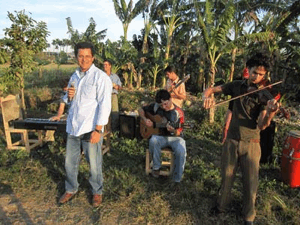
Humberto Ríos playing with his band. (Credit: Will Parrinello)
YOUNG: The richly diverse culture of Cuba comes through in its music. And the island’s rich and diverse plant life comes through in its food. Agricultural scientist and musician Humberto Rios is tapping into both. His work to support organic farming and crop diversity recently won the prestigious Goldman prize—sometimes called the Green Nobel.
Like all Cubans, Rios was profoundly challenged by the collapse of the Soviet Union. All Cuban agriculture was based on the Soviet system of monoculture crops and pesticides. With the Soviets gone, Rios needed new ways to farm.
RIOS: So I realized that we had to refocus all the plant breeding system in my country.
YOUNG: Rios turned to Cuba’s farmers. He found far more varieties of plants in their small plots than researchers were aware of. Rios realized that Cuba’s plant diversity could be its strength.
RIOS: So I start to work with farming at that time. And I realized that they had a lot of knowledge to teach me.
YOUNG: I guess it’s like having a broader toolbox when you have more variety of seeds, then you have more options for what—different soil types you can cultivate, different weather you can adjust to, that sort of thing?
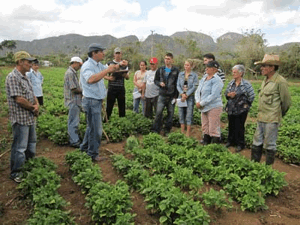
Humberto Ríos works with a community of farmers (Credit Will Parrinello)
RIOS: Yeah, yeah, it’s true. You should respect the environment instead of to transform the environment to grow the seeds.
YOUNG: Uh huh.
RIOS: It’s the way. It’s the only way around to save our culture. But most of the time the conventional scientists have been transforming the environment. To homogenize the environment at the same time to grow the same variety all over the places. So this method is promoted to look for the real diversity that can grow in a specific environment.
YOUNG: You know, we have a saying in English, I don’t know if there’s a Spanish equivalent, but it goes: if the only tool you have is a hammer, everything looks like a nail. But what you’re saying is if you have different seeds, you don’t have to be as forceful on the environment, on the land?
RIOS: Of course, you have a lot of tools, not only a hammer.
YOUNG: So what happened when you took what you were learning from farmers back to the university in Havana? Was there resistance there?
RIOS: You know, the scientists are a little bit, how can I say? Conservative. So, they classify me like big crazy guy. So, I had to overcome that, but I see the evidence was the main tool to overcome these obstacles.
YOUNG: Hmm. So what was it that persuaded those who were skeptical, was it because your method proved to be more productive?
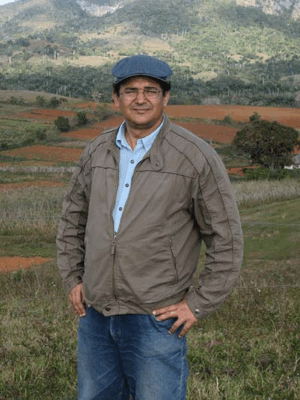
Humberto Ríos. (Credit: Will Parrinello)
RIOS: Yeah, it’s more productive, it’s in favor of diversity, and it’s more culturally appropriated. So, culture is for me a big issue.
YOUNG: When Rios says “culture” he’s speaking as a musician. He’s sows agricultural themes into his music. Music is at the heart of Cuban identity and Rios says it’s been an effective way to help him communicate.
RIOS: For example, I have popular song in Cuba; it’s called “Mango Chupe”. It’s a type of mango. This song is promoting the diversity of mango that we have in Cuba, but mango at the same time means pretty, pretty lady, or pretty guy, you know? So it’s a double meaning the people enjoy too much…
[YOUNG LAUGHS]
RIOS: You provide the subliminal message all the time. Even the policymakers dance and laugh a lot!
[MUSIC]
YOUNG: For Rios culture and agriculture are flipsides of the same coin. And diversity in one feeds the other.
RIOS: So diversity crops have to do with diversity of opinions, of diversity of selection criteria. So through thousand and thousands of years, people in the world have been able to chose the seed that they want to grow according to their culture. So you cannot separate agri with culture.

Humberto Ríos playing with his band. (Credit: Will Parrinello)
YOUNG: That’s an interesting point. I mean you can’t spell agriculture without culture.
RIOS: Sure, that is why it is very important to sing. Because it’s the accompanying of the culture to agri. I’ve farming all the time I’ve been singing! So it’s the same package that you cannot split. So that is why all the people, the farmers love this kind of job that we are doing together. It’s a real cultural exchange.
YOUNG: Rios says he hopes this kind of agriculture will continue to flourish on the island. Even as politics and economy change. He hopes the United States, just 90 miles away, will one day be an export market for organic, Cuban produce. In the meantime, there is song to spread the word.
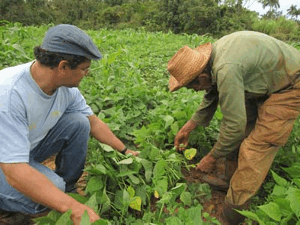
Humberto Ríos works with a farmer in a Cuban field (Credit: Will Parrinello)
RIOS: To bring some laugh, to bring someone a smile to the farm. In the way that the people can be more optimistic and more independent.
YOUNG: Humberto Rios, thank you very much, it was a great pleasure talking with you.
RIOS: Okay, thank you.
Related link:
To learn more about the Goldman Prize and to read Humberto Rios' bio, click here.
Earth Poetry
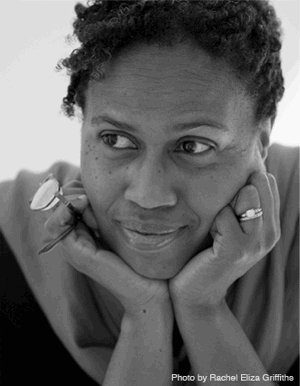
YOUNG: Coming up—revisiting the American landscape of forty years ago, through the lens of Documerica—that’s just ahead on Living on Earth.
YOUNG: It’s Living on Earth, I’m Jeff Young. April—wrote the poet—is the cruelest month, but it is also National Poetry Month. We asked poets to share work inspired by the natural world. Yes, we know April’s over but we still have more of these wonderful poems.
HARRINGTON: I’m Janice Harrington. And my interest in poetry began with passionate teachers. Passion is viral; it’s contagious. They loved poetry. I was exposed to some of the best, and I just grew up with it and kept that interest.
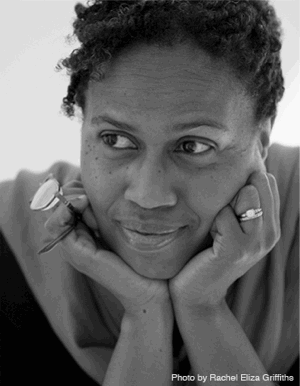
And poetry is also about paying attention to the world around you, seeing, using all your senses and I think that very much appeals to me. I grew up in Lincoln, Nebraska. And the Nebraska landscape is beautiful—these long, low rolling hills. And this poem is set in that space—that vastness of Nebraska when you’re feeling really small and insignificant. And it’s also thinking about what becomes of us, either as artists or as human beings, or our relationships even.
“Shaking the Grass”:
Evening, and all my ghosts come back to me
like red banty hens to catalpa limbs
and chicken-wired hutches, clucking, clucking,
and falling, at last, into their head-under-wing sleep.
I think about the field of grass I lay in once,
between Omaha and Lincoln. It was summer, I think.
The air smelled green, and wands of windy green, a-sway,
a-sway, swayed over me. I lay on green sod
like a prairie snake letting the sun warm me.
What does a girl think about alone
in a field of grass, beneath a sky as bright
as an Easter dress, beneath a green wind?
Maybe I have not shaken the grass.
All is vanity.
Maybe I never rose from that green field.
All is vanity.
Maybe I did no more than swallow deep, deep breaths
and spill them out into story: all is vanity.
Maybe I listened to the wind sighing and shivered,
spinning, awhirl amidst the bluestem
and green lashes: O my beloved! O my beloved!
I lay in a field of grass once, and then went on.
Even the hollow my body made is gone.
Related link:
Janice Harringont’s poem can be found in the book “Black Nature.”
[Paul Barrere & Fred Tackett “Willin” from Live From The North Café (Relix Records 2001)]
YOUNG: Janice Harrington teaches creative writing at the University of Illinois at
Urbana-Champaign. “Shaking the Grass” comes from her book “Even the Hollow my Body Made is Gone.”
[Paul Barrere & Fred Tackett “Willin” from Live From The North Café (Relix Records 2001)]
Documerica
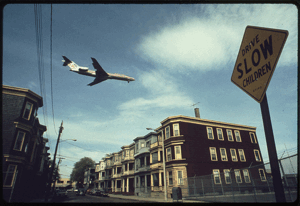
Homes near Neptune Road directly on the flight path into Boston’s Logan airport. (Photo: Michael Philip Manheim, U.S. National Archives)
YOUNG: The US Environmental Protection Agency turns 40 this year, and one of EPA’s earliest and most creative projects was called Documerica. Hundreds of photographers set out to document the nation’s environment. They produced a striking portrait of America in the midst of an environmental awakening in the early ‘70s.
Now if you’re near a computer, you might want to go to our website, loe dot org, and look at some of these photos as we hear about them from Bruce Bustard. Mr. Bustard is a senior curator at the National Archives and he’s a fan of Documerica.
BUSTARD: I think it really was the brainchild of one man. His name was Gifford Hampshire. And Gifford Hampshire had been exposed to the Farm Security Administration photographs of the 1930’s and early 1940’s. And he fell in love with these photographs, and he got it in his head that he wanted to someday do a documentary photography project.
And when he became part of the brand new Environmental Protection Agency he decided to push the idea again and he discussed it with EPA administrator, William Ruckelshaus. And Ruckelshaus thought it was a great idea and told him to go ahead and set up the project and he ended up running the project.
YOUNG: And what were the goals here, what were they trying to do with this project?
BUSTARD: Well, the mission statement said that it was going to take photographs of environmental concern. And that sounds a bit dry like there would be a lot of photographs of smog and a lot of photographs of dead fish and sewage going into rivers and things like that.
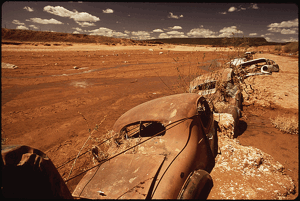
Old cars serve as water-break on Navajo Reservation. (Photo: Terry Eiler, US National Archives)
And certainly there are many, many photographs like that, but Gifford Hampshire had a rather broad idea of the environment. He followed the environmentalist Barry Commoner’s first law of ecology, which was that everything was connected to everything else and if you take that as your sort of credo, then you not only have photographs of smog and air and water pollution, but you also have a photography project that took photographs of a Hispanic ward in El Paso, and of native American reservations. It could be a photograph of great scenic beauty. So it’s a very broad range of topics.
YOUNG: He really did tap into some amazing talent here and there are amazing images. Do you have a particular favorite you want to talk about?
BUSTARD: Well, one photograph that I’m particularly fond of is a photograph that was taken during the first fuel crisis that the nation went through in the early 1970s. The photographer is a man by the name of David Falconer, and he took this wonderful photograph of a gas station that had been abandoned because of the fuel crisis and a religious organization took over the gas station.
And they painted a gigantic “Jesus Saves” sign on the actual gas station. And then they also painted the fuel pumps in bright red and purple, and the photograph shows in the foreground, the gas pumps, one is painted and it says, “Fill up with the holy ghost and fire.”
And then the other pump has an image of Jesus on it, and it says, “Fill up with old time salvation.” And so this is one of my favorites just because it’s such an imaginative composition I think and it shows again where a really creative photographer could go with an assignment to photograph the fuel crisis.
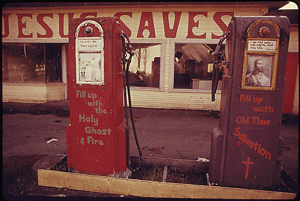
Gasoline stations abandoned during the fuel crisis in the winter of 1973-74 were sometimes repurposed. This station was turned into a religious meeting hall. (David Falconer, US National Archives.)
YOUNG: There’s another one in here I’m very fond of and it is some guys waiting for a black lung screening program.
BUSTARD: Yes, this is a photograph that was taken by a photographer by the name of Jack Corn. And his assignment was to look at life in the coal mining regions of West Virginia and Tennessee, and the effect of a poor environmental condition on the people who live there.
And so this photograph shows a group of five miners and they’re sitting in a hospital waiting room and they’re all about somewhere in their middle age, or perhaps a little bit older, and they are bare-chested, but they have their shirts are draped over them. And they’re just waiting and at least in my mind they look a bit anxious to find out whether they had any kind of problem with black lung.
YOUNG: You know, EPA, this is probably an unfair statement to a degree, but they seem to us today such a faceless bureaucracy, and yet, here is the human element of their work coming through, through these photographs. And that’s really striking to me that that to someone in the early days of this agency, anyway, is what they thought their mission should be about.
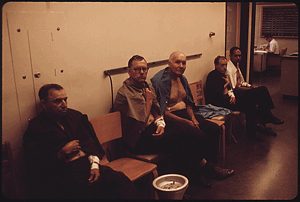
Miners at the Appalachian Regional Hospital in Beckley, West Virginia, wait for tests to determine if they have black lung disease (Photo: Jack Corn, US National Archives)
BUSTARD: I think it reflects some of the early energy in the EPA when it was first created and also reflects some of the idealism of the early environmental movement. Gifford Hampshire knew that he was kind of riding a tide of interest in the environment and he kind of seized the moment and the result were these wonderful photographs.
YOUNG: He also had the foresight to realize that a lot of the environmental issues were about cities and how people lived in the urban environment, and there’s an interesting photograph here of a, looks like plane flying very low over some row houses. Tell me about that one.
BUSTARD: This is a photograph taken by Michael Phillip Manheim, and as you said, there’s a plane that is flying low over the area that is around Logan airport, Neptune road is where most of the photographs were taken. It’s taken at a very low angle, which sort of accentuates the nearness of the plane to the houses.

Homes near Neptune Road directly on the flight path into Boston’s Logan airport. (Photo: Michael Philip Manheim, U.S. National Archives)
There’s also an interesting sign in the foreground of the photograph that says, “Drive slow, children,” which lends a certain amount of irony and context to the photograph. But Manheim was trying to document something that’s kind of difficult I think in a photograph, he was trying to document noise pollution.
YOUNG: National Archives senior curator Bruce Bustard telling us about Documerica.
[PLANE FLIES OVERHEAD]
YOUNG: Planes still roar over Neptune Road today. We went there with Documerica alumnus Michael Manheim. He photographed the Boston neighborhood in 1973. But it’s changed so much; Mr. Manheim had trouble even finding it.
MANHEIM: None of this is familiar.
YOUNG: Hmm. Do we have to walk across the tracks here?
MANHEIM: It should be there, I think.
YOUNG: Ok.
MANHEIM: The remains of Neptune Road. Let me go take a look around. Wow.
YOUNG: The last time Manheim was here, Neptune Road was lined with houses. Now airport parking lots and a runway have replaced the bustling community his lens captured in the ‘70’s.
MANHEIM: Yup, here we are.
YOUNG: This is where you used to be taking pictures of houses?
MANHEIM: Yes. There’s nothing here. And this was the street of the iconic triple-deckers. It was where people from Boston came in the summertime to get the breezes. I don’t know where the beach is now, but there’s a beach just nearby, Constitution Beach, that I photographed. And this was the—just a nice place to take a break from the city. It was one of those beauty spots.
YOUNG: Must have been tough for people who were well established in the neighborhood to see it going through those changes around the time that you were working here.
MANHEIM: One of my photographs is of a man holding up pictures of his kids playing in a park that became an airport runway. And one of the old-timers, of course, they knew what it was like. And there was no spotting this.
[PLANE FLIES OVERHEAD]
MANHEIM: So, yeah, you can hear how terrible it would be to live here. And essentially they were driven out.
YOUNG: If not just the airplanes, it’s the train, it’s the traffic, it’s just an impressive audio environment.
MANHEIM: So, it’s a wonderful place for people not to live, but it used to be bucolic.
YOUNG: You know, they could have documented this other ways, and today we’re accustomed to an environmental measurement is in the form of some charts and graphs and whatnot. Why photography? What made photography seem like a good tool for the EPA to document our environment?
MANHEIM: I don’t know. There’s always the power of the photograph. If you can catch the epitomizing moment, you’ve really spelled it out for people. You have something they can study and think about it, it’s not just flicking by—focus on that image. If it arrests you, it has an emotional impact.
YOUNG: Also, it strikes me that there are people in those photographs, and if you get a chart or a graph, there’s no people there. It’s a reminder that in the end these environmental trends, they’re about people—they’re about us!
MANHEIM: So in the photographs you find the humanity, it’s true.
YOUNG: One of Gifford Hampshire’s goals for Documerica was to record change over time. But the EPA cut the project’s funding after just a couple of years. So we asked Michael Manheim to follow up on his assignment from the ‘70s and document Neptune Road as it is today.
M: Let’s do it. I don’t know where. I used to have subject matter.
YOUNG: Now we have vacant lots.
MANHEIM: Yeah…
YOUNG: We stood among the broken bottles and cracked concrete on a footbridge over the commuter rail—a remnant from the days when there were still homes to get to across the tracks on Neptune road. Manheim snapped shots of security walls and airport delivery trucks splashing through puddles.
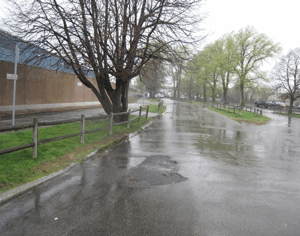
Neptune Road today. (Photo: Michael Philip Manheim)
MANHEIM: And this is how we start telling a story with the camera, we just keep walking and looking...
[PLANE AND TRAIN PASSING]
YOUNG: You can see the photos from Michael Manheim’s return to Neptune Road and check out the rest of the Documerica collection, at our website, loe dot org.
[SFX PLANE, TRAIN FADES]
Related links:
- To see more pictures of Neptune Road in the 1970s, click here.
- Check out the rest of the photos in the Documerica collection.
- Want to know more about Documerica?
- Click here to see more of Michael Manheim’s pictures.
Bird Wonder
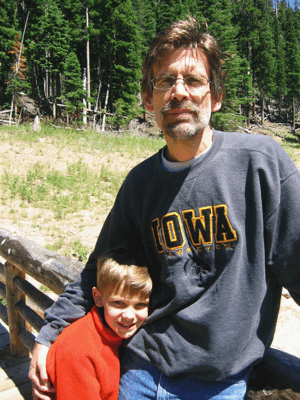
YOUNG: Some birders travel great distances to see rare species, filling out impressive life lists of species. But not commentator Tom Montgomery-Fate. Tom and his boy let the birds travel to them, as their migrating friends return to the Midwest.
MONTGOMERY-FATE: My eight-year-old son Bennett and I like to watch birds at our back yard feeders. We have a pair of binoculars, a field guide, and a little journal to keep track of what we see. That’s the point for me—not seeking out rare birds or dozens of different species—but just learning to see the ordinary birds that live here, in suburban Chicago.
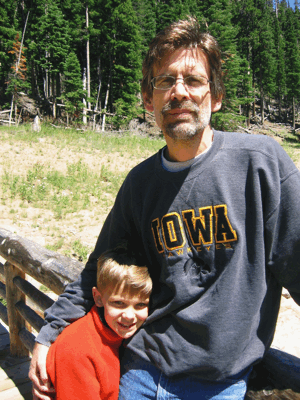
Four house sparrows are scratching in the seed when a male cardinal drops in out of nowhere like a shiny winged fire engine pulling up to a working class bar. As the chattering sparrows makes way for the noble bird I tell Bennett how the Cardinal got its name. Due to its stiff triangular crest and bright red feathers the male cardinal was named after its Catholic counterpart in the church. We muse about whether the naming has anything to do with its behavior. Does the bird have an elevated sense of morality? When he flies away I imagine he’s off to address a flock of sinful starlings—to hold a chirpy mass in some huge lilac bush with a communion of mulberry juice and crickets. But instead he flies to his mate, who is singing from a nearby elm branch. He feeds her the seed he has brought her.
I don’t tell Bennett that Cardinals are single and celibate. Nor how amused I am by the clutch of red finches that have now gathered around the feeder. Whenever the Cardinal returns to the feeder they all quickly drop to the ground to gobble up the tiny grains that he scatters on them in an odd sort of baptism. “Look, he’s kicking the food to them,” Bennett says. “Yeah,” I say. “And they seem thankful.”
Later, two robins, a nuthatch, and a few sparrows are all having a quiet snack when a raucous gang of grackles arrive, they crash the birdfeeders like drunk conventioneers who can’t believe they’ve stumbled onto a free smorgasbord. It takes a minute for Bennett to figure out that the birds are grackles and not starlings. The guide helps: grackles walk on the ground. But starlings don’t; like robins, they hop. We both like identifying the birds by behavior rather than color—seeing more than the most obvious markers.
“I count twenty-four,” Bennett says. He watches the birds intently. We try to distinguish the males from females and the juvenile birds from the mature birds. It’s difficult, but the longer we watch the more we see.
Related link:
Selected works of Tom Montgomery-Fate
[The Crusaders “When There’s Love Around” from Southern Comfort (Verve Music Group 1971)]
YOUNG: Tom Montgomery-Fate teaches writing at College of DuPage in Glen Ellyn, Illinois. His nature memoir will be published next year by Beacon Press.
[The Crusaders “When There’s Love Around” from Southern Comfort (Verve Music Group 1971)]
YOUNG: Living on Earth is produced by the World Media Foundation. Our crew includes Bobby Bascomb, Eileen Bolinsky, Bruce Gellerman, Ingrid Lobet, Helen Palmer, Jessica Ilyse Smith, Ike Sriskandarajah, and Mitra Taj, with help from Sarah Calkins, Marilyn Govoni and Sammy Sousa. Our interns are Emily Guerin and Bridget Macdonald. Jeff Turton is our technical director. Alison Lirish Dean composed our themes. Our executive producer is Steve Curwood. You can find us anytime at LOE dot org. I’m Jeff Young. Thanks for listening.
Funding for Living on Earth comes from the National Science Foundation, supporting coverage of emerging science. And Stonyfield Farm organic yogurts and smoothies. Stonyfield pays its farmers not to use artificial growth hormonal on their cows. Details at Stonyfield dot com. Support also comes from you, our listeners, the Ford Foundation, the Town Creek Foundation, The Oak Foundation supporting funding of climate change and marine issues. The Bill and Melinda Gates Foundation dedicated to the idea that all people deserve a chance to lead a healthy productive life. Information at Gates Foundation dot org. And Pax World Mutual Funds integrating, environmental, social and governance factors into investment analysis and decision-making on the web at Pax World dot com. Pax World for tomorrow.
Living on Earth wants to hear from you!
Living on Earth
62 Calef Highway, Suite 212
Lee, NH 03861
Telephone: 617-287-4121
E-mail: comments@loe.org
Newsletter [Click here]
Donate to Living on Earth!
Living on Earth is an independent media program and relies entirely on contributions from listeners and institutions supporting public service. Please donate now to preserve an independent environmental voice.
NewsletterLiving on Earth offers a weekly delivery of the show's rundown to your mailbox. Sign up for our newsletter today!
 Sailors For The Sea: Be the change you want to sea.
Sailors For The Sea: Be the change you want to sea.
 Creating positive outcomes for future generations.
Creating positive outcomes for future generations.
 Innovating to make the world a better, more sustainable place to live. Listen to the race to 9 billion
Innovating to make the world a better, more sustainable place to live. Listen to the race to 9 billion
 The Grantham Foundation for the Protection of the Environment: Committed to protecting and improving the health of the global environment.
The Grantham Foundation for the Protection of the Environment: Committed to protecting and improving the health of the global environment.
 Contribute to Living on Earth and receive, as our gift to you, an archival print of one of Mark Seth Lender's extraordinary wildlife photographs. Follow the link to see Mark's current collection of photographs.
Contribute to Living on Earth and receive, as our gift to you, an archival print of one of Mark Seth Lender's extraordinary wildlife photographs. Follow the link to see Mark's current collection of photographs.
 Buy a signed copy of Mark Seth Lender's book Smeagull the Seagull & support Living on Earth
Buy a signed copy of Mark Seth Lender's book Smeagull the Seagull & support Living on Earth

